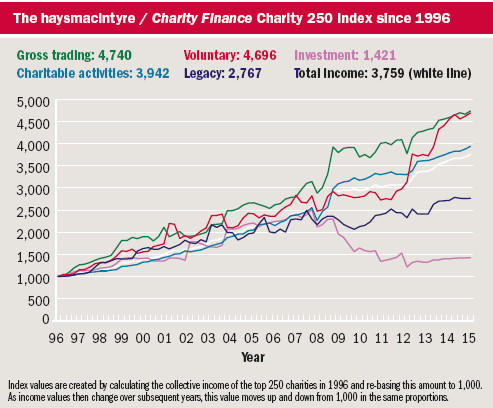Diane Sim reports on a positive quarter for the Charity 250 Index, and on strategies for boosting the income of professional associations.
The haysmacintyre / Charity Finance Charity 250 Index enjoyed a strong quarter in the three months to 30 September 2015, rising 58 points, some 25 points ahead of its average quarterly rise. All income streams performed above expectation, led by trading and voluntary income, which beat their quarterly benchmarks by 49 and 45 points respectively.
A major contributor to this positive result was the independent schools sector, which accounts for over 70 per cent of charities reporting results in the third quarter. Almost 80 per cent of schools reported income rises, including four schools reporting increases of over 10 per cent.
In spite of the pressures on school fees, their main source of income, independent schools collectively outperform the index and therefore have a bolstering effect on the overall figures.
Looking ahead, over half of the charities with financial year ends falling in the fourth quarter have now filed their accounts, and these are included in the table on page 55. The composition of charities with quarter-four year-ends is considerably more diverse than those with quarter-three year-ends, with a strong showing from religious organisations and professional membership associations.
Membership organisations
Across both the Charity 100 and the Charity 250 Indexes, there are almost 20 professional membership organisations, ranging from the General Medical Council and the Nursing and Midwifery Council in the Charity 100 Index, with annual income of £99.3m and £73.2m respectively, to smaller associations with annual income of £26.2m and above.
Given the broad range of professional associations in the UK, this may be fewer than one might initially expect, but not all professional associations are charities; only those that exist to provide public benefit are, rather than those for the private benefit of a special interest group. A high-profile example is the Royal College of Nursing, which ceased to be a charity and a member of the Charity 100 Index in 2010, setting up a new charity called the RCN Foundation instead. This was designed to separate the charitable and noncharitable (mainly trade-union-related) elements of the RCN’s work.
Given that a significant proportion of a professional association’s income derives from membership fees, organisations where professionals must be registered in order to practice are more insulated from financial pressures than those organisations where membership is voluntary.
“Professional associations are undoubtedly trying to control costs, so that they can limit membership fee increases, particularly where membership is voluntary,” says haymacintyre partner Kathryn Burton. “At the same time, many are investing in their own employees to develop their services, in some cases funding these new initiatives from reserves rather than passing on the costs directly.”
Moreover, fees earned from traditional membership services are no longer quite as robust and reliable as they used to be. “Publishing revenues are being challenged by the trend to an open-access model, while conference revenues are under pressure from rising costs and an increasingly price-sensitive audience, particularly in public sector organisations such as the NHS and universities,” says Burton.
Power of association
There is evidence of a variety of strategies to increase membership numbers, such as introducing student tiers of membership, and diversifying income streams.
Meanwhile, collaboration with other professional bodies is also becoming more common. For example, the premises-sharing arrangements of several professional associations and charities active in biosciences at Charles Darwin House in London enable them to share costs and promote their services to interested parties beyond their individual memberships.
Cross-border collaboration in areas such as publishing, events and qualification accreditation is also becoming more common.
While fees from members form a significant income stream for professional associations, there are others. “Professional associations are beginning to look more closely at opportunities for project-based grant funding and many have large investment portfolios,” says Burton.
“They don’t tend to have a strong track record in fundraising, but there is scope to do more here, particularly as many have key milestones approaching and are planning profile-raising anniversary celebrations,” she adds.
A very positive trend over the last few years has been improved corporate governance. “The trustee body of a professional association has traditionally come from within the membership. Over the last five years we have seen more external appointments to ensure a broader base of requisite skills,” says Burton.










